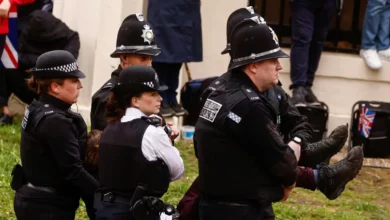The potential seems almost endless. More than two hundred thousand people have registered their support on the Facebook page “We are all Khaled Saeed”. Thousands of suggestions have flooded the web page calling for near-monthly silent stands across Egypt. Hundreds of supporters have sent their personal photographs holding placards expressing their solidarity with Saeed. Personal and family photos of the young Alexandrian are displayed on the internet in his memory. Many of those rallying behind the cause deliver a common message: that Saeed was an “ordinary” Egyptian citizen whose fate can befall anyone of them.
Commentary and pictures on the page suggest that thousands of young people across the Arab world see themselves in Saeed's shoes. One protester, who I met last June at the first demonstration in Cairo calling for the case to be re-investigated, explained to me that the police had exceeded their limits and were no longer able to distinguish between “criminals and good people.” It was Saeed’s innocent-looking photograph that prompted this young person to take interest in the case.
While it’s imperative to condemn acts of torture when they occur, it is also necessary to take a closer look at the the public debate around torture and its social consequences. What is torture? Who counts as a torture victim and how are they represented publicly? Do torture debates question all acts of violence used by security authorities against different victims? Or have such debates, directly or indirectly, legitimated the use of violence and abuse through indifference to certain cases?
The language of crime-reporting in national newspapers can often sink into a very procedural tone, replicating almost exactly the manner in which public prosecution reports are written–evidential, dead-cold objective and detailed only in attempt to condemn. Thus, it is important that Saeed’s supporters present him with a human face, through pictures depicting his everyday life, to counter these sterile descriptions. Such an assertive challenge however is not without its problems: By humanizing Saeed, his supporters also help to normalize our understanding what constitutes a torture victim.
My conversation with the protester is quite telling of the ways certain torture victims are represented in order to draw public sympathy. By emphasizing Saeed’s innocence and ordinariness as reasons to rally behind his cause, the protester, unknowingly perhaps, counters images of Saeed, prevalent in state newspapers like Al-Gomhoriya, as a drug addict unworthy of public support. But as Egyptian human rights organizations like El Nadim Center for Rehabilitation of Victims of Violence have pointed out, even if Saeed was a drug dealer he does not deserve to die in such a horrid manner. The public debate following Saeed’s death almost seemed to defend his social image and his unquestionable innocence as represented by his angelic figure in the photograph, sometimes at the expense of focusing on the brutality and impudence of the police.
Systemic torture in Egypt has been ongoing for nearly twenty years. It is no longer limited to particular nodes (key police stations, detention centers, certain police officers in the security services). The security apparatus has in fact penetrated throughout much of Egyptian society, exercising a monopoly over the resolution of sectarian disputes and long-standing family feuds in places like Upper Egypt. It affects everyday life in this country.
Curiously, police torture practices that were prevalent in popular quarters and squatter areas over the past two decades have remained isolated from wider public debates and have failed to generate anything resembling the movement in support of Saeed. Here we are talking about torture cases affecting a long list of “criminals”: drug dealers and addicts, prostitutes, street-children, delinquents, Islamic Jihadists, to name a few. The regime’s “silent” war on terrorism in the early 1990s, for example, involved many cases of illegal detention, abuse and torture against Jihadists.
Despite the fact that Egypt has seen greater press freedom in the last few years, creating an atmosphere which has fostered public debates about torture cases, these debates also shape modes of visibility. They affect the way we see and recognize torture victims, causing us to rally around particular cases and not others. As a result, certain torture victims become “normalized” while other instances of police abuse are covered up.
Perhaps Saeed's case has cast a stone in still waters. But moving forward, it will be necessary to open an entire archive of abuses in Egypt’s recent history without preconditions and prejudices.
Fouad Halbouni is a graduate student in the anthropology department at Johns Hopkins University.




